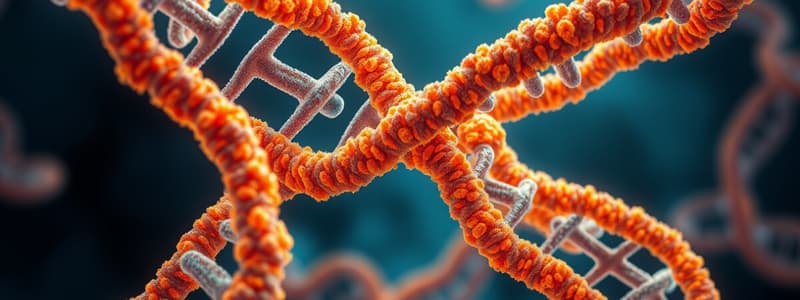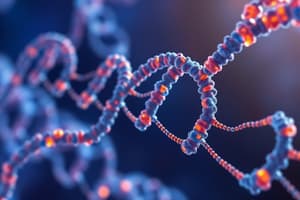Podcast
Questions and Answers
What is the role of the cell cycle control system?
What is the role of the cell cycle control system?
During which phase does the synthesis of DNA and duplication of chromosomes occur?
During which phase does the synthesis of DNA and duplication of chromosomes occur?
What happens to a cell in the G0 phase?
What happens to a cell in the G0 phase?
What triggers the cell cycle to move past checkpoints?
What triggers the cell cycle to move past checkpoints?
Signup and view all the answers
What characterizes the G2 phase of the cell cycle?
What characterizes the G2 phase of the cell cycle?
Signup and view all the answers
How is the cell cycle controlled?
How is the cell cycle controlled?
Signup and view all the answers
Why is the cell cycle considered highly regulated?
Why is the cell cycle considered highly regulated?
Signup and view all the answers
What distinguishes the G1 phase of the cell cycle?
What distinguishes the G1 phase of the cell cycle?
Signup and view all the answers
What is the primary structure that makes up eukaryotic chromosomes?
What is the primary structure that makes up eukaryotic chromosomes?
Signup and view all the answers
When do chromosomes form during the cell cycle?
When do chromosomes form during the cell cycle?
Signup and view all the answers
What is the role of cohesins in a duplicated chromosome?
What is the role of cohesins in a duplicated chromosome?
Signup and view all the answers
What is the diploid number of chromosomes in humans?
What is the diploid number of chromosomes in humans?
Signup and view all the answers
What happens to chromatids during cell division?
What happens to chromatids during cell division?
Signup and view all the answers
What defines a haploid cell?
What defines a haploid cell?
Signup and view all the answers
Where are haploid cells typically found in humans?
Where are haploid cells typically found in humans?
Signup and view all the answers
What occurs to chromatin at the end of cell division?
What occurs to chromatin at the end of cell division?
Signup and view all the answers
What is the primary role of the M Phase Checkpoint in the cell cycle?
What is the primary role of the M Phase Checkpoint in the cell cycle?
Signup and view all the answers
Which factor can cause a cell to enter a resting state known as G0?
Which factor can cause a cell to enter a resting state known as G0?
Signup and view all the answers
What happens during the G2 Checkpoint?
What happens during the G2 Checkpoint?
Signup and view all the answers
Why is it important for damaged DNA not to be passed onto daughter cells?
Why is it important for damaged DNA not to be passed onto daughter cells?
Signup and view all the answers
What triggers the cell to pause mitosis?
What triggers the cell to pause mitosis?
Signup and view all the answers
What is the consequence of not receiving positive signals at the G1 Checkpoint?
What is the consequence of not receiving positive signals at the G1 Checkpoint?
Signup and view all the answers
What does the spindle checkpoint ensure before anaphase begins?
What does the spindle checkpoint ensure before anaphase begins?
Signup and view all the answers
What is referred to as 'straggler' chromosomes?
What is referred to as 'straggler' chromosomes?
Signup and view all the answers
What is the role of cyclins in cell cycle regulation?
What is the role of cyclins in cell cycle regulation?
Signup and view all the answers
What is MPF and its significance in the cell cycle?
What is MPF and its significance in the cell cycle?
Signup and view all the answers
How do growth factors influence the cell cycle?
How do growth factors influence the cell cycle?
Signup and view all the answers
What does anchorage dependence refer to in cell division?
What does anchorage dependence refer to in cell division?
Signup and view all the answers
What occurs when the cyclin-CDK complex has fulfilled its role?
What occurs when the cyclin-CDK complex has fulfilled its role?
Signup and view all the answers
In density-dependent inhibition, what happens to crowded cells?
In density-dependent inhibition, what happens to crowded cells?
Signup and view all the answers
What characterizes cancer cells compared to normal cells?
What characterizes cancer cells compared to normal cells?
Signup and view all the answers
What is one main factor that determines the number of cells in a tissue?
What is one main factor that determines the number of cells in a tissue?
Signup and view all the answers
Why are older people more commonly affected by cancer?
Why are older people more commonly affected by cancer?
Signup and view all the answers
What does it mean to be predisposed to cancer?
What does it mean to be predisposed to cancer?
Signup and view all the answers
What is a primary cancer?
What is a primary cancer?
Signup and view all the answers
What is the main route by which cancer cells spread to distant organs?
What is the main route by which cancer cells spread to distant organs?
Signup and view all the answers
What is referred to as metastasis in the context of cancer?
What is referred to as metastasis in the context of cancer?
Signup and view all the answers
Why do cancer cells often spread to the lungs?
Why do cancer cells often spread to the lungs?
Signup and view all the answers
What generally happens to cancer cells as they travel through the lymphatic system?
What generally happens to cancer cells as they travel through the lymphatic system?
Signup and view all the answers
What is a consequence of removing nearby lymph nodes during tumor removal?
What is a consequence of removing nearby lymph nodes during tumor removal?
Signup and view all the answers
Study Notes
Chromosomes and Chromatin
- Eukaryotic chromosomes are composed of chromatin, a DNA-protein complex.
- Chromatin condenses during cell division, resulting in visible chromosomes.
- Chromosomes are only formed when cells divide, disappearing during non-dividing phases.
Chromosome Structure
- DNA is replicated during cell division, leading to the formation of two sister chromatids.
- Sister chromatids are connected at the centromere, where they are most closely attached.
- Haploid cells contain one set of chromosomes (n=23 in humans, found in gametes).
- Diploid cells contain two sets of chromosomes (2n=46 in humans, found in somatic cells).
Cell Cycle Overview
- The cell cycle includes stages for growth and division, regulated to ensure accurate DNA distribution.
- G1 (First Gap): Initial growth and organelle production.
- S phase: DNA synthesis and chromosome duplication.
- G2 (Second Gap): Further growth and preparation for mitosis.
- G0 (Resting State): Non-dividing cells performing normal functions, can be reversible or permanent.
Cell Cycle Control Points
- The cell cycle is directed by a control system with specific checkpoints for progression.
- Checkpoints assess DNA integrity and proper chromosome attachment before division.
- M Phase Checkpoint: Ensures chromatids are correctly attached to spindle fibers before anaphase begins.
Regulatory Proteins
- Two primary types control the cell cycle: Cyclins and Cyclin-dependent Kinases (Cdks).
- Cdks activate when bound to cyclins, with their activity fluctuating based on cyclin concentration.
- MPF (maturation-promoting factor) is a cyclin-Cdk complex that facilitates the transition from G2 to M phase.
Cancer Cells Characteristics
- Cancer cells bypass normal regulatory signals, leading to uncontrolled growth.
- Mutations can predispose individuals to develop cancer, often discovered over multiple cell divisions.
- Cancer cells can invade nearby tissues (local spread) and disseminate to distant sites via blood or lymph (systemic spread).
- Metastasis involves primary cancer cells establishing new tumors in separate organs, commonly in the lungs or lymph nodes.
Metastasis Process
- Cancer cells may break from the primary tumor and enter circulation through blood or lymph vessels.
- They typically immobilize at the first narrow passage, such as in lung capillaries or lymph nodes, leading to secondary tumor formation.
Studying That Suits You
Use AI to generate personalized quizzes and flashcards to suit your learning preferences.
Description
This quiz explores the structure and function of eukaryotic chromosomes, focusing on chromatin's role during cell division. Understand how DNA and protein complexes condense to form visible chromosomes under a microscope. Test your knowledge about the dynamics of chromatin and the presence of chromosomes.




